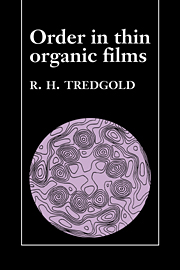Book contents
3 - Films at the air/water interface
Published online by Cambridge University Press: 21 September 2009
Summary
Trough technology
Amphiphilic materials spread at the air/water interface have been the subject of intensive study over a long period of time. The type of apparatus usually used for this purpose has much in common with the apparatus needed to form Langmuir–Blodgett films and, indeed, it is usually possible to adapt the same apparatus for both purposes. In this section the problems which must be overcome if these processes are to be carried out are discussed and the most effective solutions to these problems described.
It has become traditional to use the word ‘trough’ to denote such apparatus and this usage will be adhered to here though the word trough tends to suggest such things as hogwash rather than the ultra-cleanliness needed for effective studies of monolayers. It is indeed this cleanliness which must be our first concern. Many materials which would otherwise be suitable for the fabrication of troughs tend to leach out surface active material into the water based subphase contained in the trough and thus can not be used. Most modern troughs are made in one of the two following ways.
Teflon (polytetrafluoroethylene) does not leach out plasticisers and can be purchased in substantial blocks, sheets and rods of various thicknesses. The preferred method is to machine a trough from a solid block of this material. This is a practicable procedure if a good milling machine is available but one is limited to a rather shallow trough. […]
- Type
- Chapter
- Information
- Order in Thin Organic Films , pp. 39 - 58Publisher: Cambridge University PressPrint publication year: 1994

